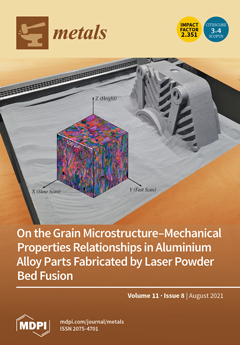Palladium (Pd) electroplating is widely practiced in the manufacture of advanced electronic devices. The Pd(II) present in spent electroplating solutions is treated by cementation with zinc (Zn) metal powder. In order to recover pure Pd from the cemented Pd, a process that consisted of leaching followed by solvent extraction was investigated. For this purpose, solvent extraction experiments using synthesized ionic liquids (ILs) with organic and inorganic anions were performed to find separation conditions at which selective extraction of Pd(II) over Zn(II) from synthetic H
2SO
4 leaching solutions is possible. The concentration of sulfuric acid was varied from 0.5 to 9 M. The complete separation of Pd(II) over Zn(II) by ILs such as ALi–CY301 (
N-methyl-
N,
N,
N-trioctylammonium bis(2,4,4-trimethylpentyl) dithiophosphinic), ALi–SCN (
N-methyl-
N,
N,
N-trioctylammonium thiocyanate), ALi–I (
N-methyl-
N,
N,
N-trioctylammonium iodide) and ALi–Br (
N-methyl-
N,
N,
N-trioctylammonium bromide) depends on H
2SO
4 concentration, while ALi–LIX63 (
N-methyl-
N,
N,
N-trioctylammonium 5,8-diethyl-7-hydroxydodecane-6-oxime) and ALi–LIX84 (
N-methyl-
N,
N,
N-trioctylammonium 2-hydroxy-5-nonylacetophenone oxime) can completely separate Pd(II) irrespective of H
2SO
4 concentration. Additionally, the mixture of HCl and thiourea, aqua regia solution, NH
3 solution and the mixture of NH
4Cl and NH
3 are powerful stripping agents for Pd(II) from the loaded ALi–LIX63/ALi–LIX84, ALi–CY301, ALi–Br/ALi–I and ALi–SCN, respectively. However, application of the separation conditions to the real 5 M sulfuric acid leaching solutions of cemented Pd indicated that it was difficult to separate the two ions by extraction with ALi–LIX63 and ALi–LIX84. Use of NaClO as an oxidizing agent during the sulfuric acid leaching of real cemented Pd resulted in an enhancement of Zn(II) extraction by ALi–LIX63 and ALi–LIX84. Therefore, removal of chloride ions from the sulfuric acid leaching solutions is necessary to apply the separation conditions obtained from synthetic sulfuric acid leaching solutions.
Full article





